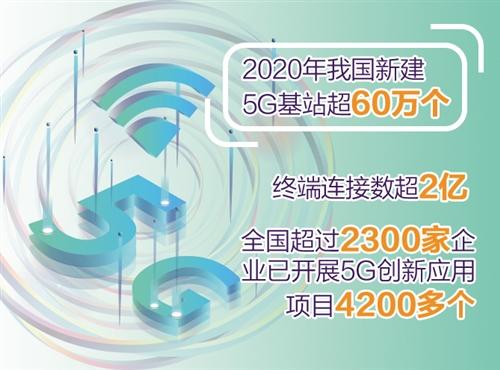Recently, data released by the Ministry of Industry and Information Technology show that in 2020, my country will have more than 600,000 new 5G base stations, all cities above the prefecture level will achieve full coverage of 5G networks, the number of 5G terminal connections will exceed 200 million, and the digitalization of various industries will continue to accelerate. .
Under this circumstance, my country's 5G commercial situation has attracted much attention.
"The 200 million terminals mainly come from mobile phones, including some industry terminals. As of December 2020, 5G mobile phone shipments accounted for 68.4%." Peng Jian, deputy director of the Radio Management Institute of CCID Think Tank, told reporters that 5G mobile phones It has become the mainstream market and the preferred choice for users to change phones. As of December 2020, the average monthly Internet traffic (DOU) per household for mobile phone users has been close to 12GB. 5G has played a huge role in the rapid growth of Internet traffic.
It is worth mentioning that China Mobile has opened 390,000 5G base stations, which can provide 5G independent networking services for all prefecture-level cities and some key counties across the country.
This means that for most urban mobile phone users, the 5G network has become another alternative main network service after 4G.
From the comparison of the data of 4G and 5G over the same period, after one year of commercial use, the number of base stations of the two is basically the same, but the number of users is quite different. As of the end of 2014, the number of 4G users in my country was 97.284 million, and as of the end of 2020, Only China Mobile and China Telecom's 5G package users exceeded 250 million, with a penetration rate of over 16%.
With strong policy support and the joint efforts of all parties in the industry chain, 5G has surpassed the number of users of 4G in the same period.
People in the industry generally believe that 5G has promoted the transformation and upgrading of user information consumption. People are paying more and more attention to new terminals such as VR/AR smart headsets, wearable devices, and Internet of Things products, and consumption potential will continue to be released.
"From the perspective of the personal consumption market, although 5G has not yet seen phenomenal applications such as webcasting in the 4G era, the construction of any generation of mobile communication networks must respect its objective development laws, such as ultra-high-definition video, 5G news, and 5G cloud games. The application of mobile phone users has yet to be explored by all parties in the industry chain." Peng Jian said.
"In the past year or so since 5G was commercialized, industry applications have achieved breakthroughs from 0 to 1." Wang Zhiqin, vice president of China Academy of Information and Communications Technology, said that at present, more than 2,300 companies across the country have carried out more than 4,200 innovative 5G application projects. , Mining, medical, transportation, energy, intelligent manufacturing and other fields are actively exploring.
Taking the application of 5G in the field of intelligent manufacturing as an example, Xinfengming Group is engaged in many production processes in the chemical fiber industry, among which phenomena such as "floating silk" and "wandering" often appear in the spinning process.
The traditional solution is to rely on human eyes to distinguish, but due to the low frequency of inspections, missed inspections often occur, so the industry's excellent product rate is always stuck at around 98%.
In order to increase the rate of high-quality products, Xinfengming Group has built a 5G intelligent workshop-an inspection robot with 8K high-definition cameras instead of manual inspections to meet the requirements of ultra-high-precision inspection.
At the same time, based on the 5G high bandwidth and low latency capabilities, the big data collected by the robot can be transmitted to the monitoring center in real time, and the data required for the business can be generated through the analysis of the background intelligent analysis algorithm.
It is estimated that this will effectively increase the rate of superior products and bring direct revenue of 20 million yuan to the group every year.
"Despite a good start to my country's 5G network construction, industry applications are still in the lead-in period. Problems such as weak industrial infrastructure support and unclear business models still exist. It is difficult to eliminate barriers to cross-industry integration and it will take time to achieve large-scale applications." In Wang Zhiqin's view, the next step should be to vigorously promote 5G integration applications, and form a benign development model of "building to promote use, use to promote construction".
Encourage all walks of life to carry out technological innovation for application scenarios, select integrated application demonstration benchmarks, and publish application implementation guidelines for key industries.
Accelerate the promotion of 5G applications in key industries such as industrial Internet, medical care, energy, and ports, expand the exemplary role of 5G online education, logistics and other fields, and create more typical application scenarios.
At the same time, it is necessary to promote the construction of public service platforms such as 5G testing laboratories and innovation centers in various regions, and unite all parties in the industry to carry out 5G application model innovation and key technology research and development, 5G application testing and verification, and business model incubation.
"Accelerate 5G application certification and supply-demand docking, and incubate and cultivate a group of solution providers who understand both 5G and industry applications based on industry application needs." Wang Zhiqin said.
Our reporter Li Pengda

